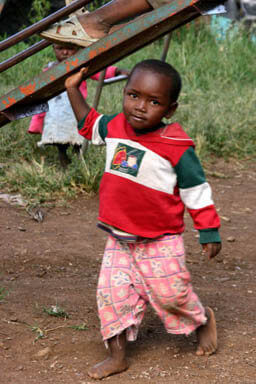Kim LufkinGHTC
Kim Lufkin is a communications officer at GHTC.
GHTC’s Kim Lufkin is in Kenya this week, documenting global health research projects and the impact on people in the country. This is her first post from the field.
On Tuesday, our team went to visit the US Embassy in Nairobi in order to meet with some fantastic Americans working in Kenya for several US agencies, like the CDC, USAID, State Department and DoD. On the way through security, the guard pulled out the small device I constantly carry in my purse to monitor my blood glucose levels—I’ve been a Type I diabetic since age five.
I realized how fortunate I am to have a quick, easy-to-use diagnostic tool that I can carry with me wherever I go. In fact, the range of testing and treatment options made available to me has grown leaps and bounds since I was a child, thanks to research and development for new diabetes products. This realization in the security line at the US Embassy stood in stark contrast to the diagnostic and treatment tools available to children in Kenya suffering from a painful and deadly neglected disease called visceral leishmaniasis, or VL. These children are in desperate need of new diagnostic and treatment tools.
I remember when I was first diagnosed with diabetes at five years old, there wasn’t a fast and accurate way to monitor my glucose levels. My mom would prick my finger to withdraw blood, and then apply my blood to a small test strip. After waiting a short amount of time, she’d wipe the blood away, and the strip would change colors. She’d then have to compare the color to photos on the back of the bottle, making her best guess about what range my glucose level fell within. And the level wasn’t even current – it represented what my glucose level was several hours before—making preparing my insulin dose even that much more difficult. My mom would then have the constant battle of giving me my insulin with a syringe injection at least three times a day, which I fought tooth and nail every time.

This hardly compares with the process children in Kenya have to suffer through in order to determine if they have VL. On Monday, we met with Simon Bolo—an inspiring man who works with the Drugs for Neglected Diseases initiative (DNDi) in Nairobi. He told us how the only 100% accurate ways of diagnosing VL, even for children, involves incredibly painful punctures to their spleen or bone marrow. Both are conducted with giant needles required to pierce the skin and bone marrow.
Children suffering from VL deserve the same commitment to research that I’ve benefited from as a diabetic in the US. Over the past 20 years, the methods available to me to test my glucose levels throughout the day have vastly improved—I now have a small machine that requires little blood and gives me accurate results in five seconds. My treatment options have also advanced, from the types of insulin available to me and the fact that I now use an insulin pump, doing away with the need for multiple injections every day. Because of these improvements, my overall health as a diabetic has improved tremendously.
A matched commitment to research for neglected diseases such as VL could have the same results for children in Kenya and around the world. These children should not have to go through such painful diagnostic procedures to confirm whether they have VL—imagine if they had access to a simple, effective, and rapid blood test that they could easily access in their community’s clinic. VL affects the “poorest of the poor,” Simon told us on Monday. “Our governments need to wake up and take responsibility” for supporting research that can lead to lifesaving new tools. Children in Kenya deserve the same access to modern and effective diagnostics and treatment that I’ve has as a diabetic in the US. Increased support for neglected disease research can provide them with that.